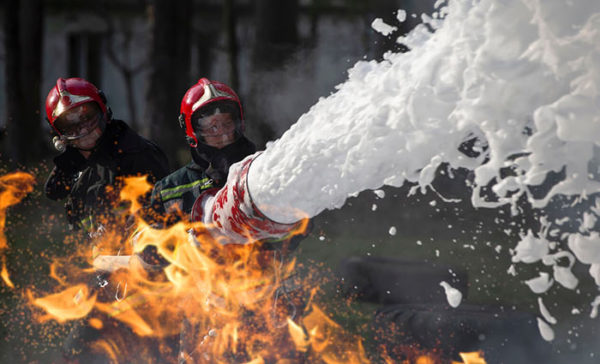Firefighting Foam Military PFAS Exposure
Aqueous film-forming foam (AFFF) contains man-made chemicals known as per- and polyfluoroalkyl substances (PFAS) and has been used to put out fires for decades. Sadly, AFFF has been linked to an increased risk of cancer and other illnesses. Military firefighters are especially at risk. See if you can work with a top AFFF lawyer to pursue compensation and VA benefits for cancer caused by exposure to AFFF.
Why Take Legal Action?
By filing a lawsuit, you can pursue financial compensation and justice from those who caused you or a loved one harm.
AFFF & PFAS Exposure in the Military
In the 1960s, the U.S. Department of Defense (DOD) mandated that all branches of the military use AFFF to put out high-intensity fires involving highly flammable liquids, like jet fuel and oil.
As a result, military firefighters have been exposed to PFAS at high levels. PFAS, also known as “forever chemicals,” can build up in the body over time and cause several types of cancer and other serious health problems.
The DOD is investigating PFAS contamination at over 700 military bases, according to the Environmental Working Group (EWG), an organization that studies health and the environment.
EWG has already documented contaminated drinking water, groundwater, or both at more than 450 military installations across the country.
The DOD is planning to phase out the use of AFFF, but for many veterans and active military personnel, the damage has already been done.
Quick Facts About Firefighting Foam Military Exposure
- At-risk populations: Military firefighters, civilian firefighters, and people living near military bases with PFAS contamination
- Chemicals: Perfluoroalkyl and poly-fluoroalkyl substances, also known as PFAS or “forever chemicals”
- Manufacturers: 3M Company, DuPont™, Chemours, and other large chemical makers
- Related health problems: Over 10 types of cancer, including prostate cancer, testicular cancer, and kidney cancer, as well as thyroid disease and ulcerative colitis
LawFirm.com works with top AFFF lawyers who have secured over $9.8 billion for those harmed through no fault of their own.
Get a free case review right now to see if they can help you get the compensation you deserve.
U.S. Military Firefighting Foam & Cancer
Federal health agencies, including the Centers for Disease Control and Prevention (CDC) and the U.S. Environmental Protection Agency (EPA), have reported that PFAS exposure may be hazardous.
“Current scientific research suggests that exposure to high levels of certain PFAS may lead to adverse health outcomes.”
– U.S. Environmental Protection Agency (EPA)
PFAS have been nicknamed “forever chemicals” because they don’t break down naturally. As a result, once someone has been exposed to PFAS in military firefighting foam, these durable chemicals accumulate inside the body and may lead to serious health conditions.
PFAS-related illnesses include:
- Bladder cancer
- Breast cancer
- Kidney cancer or renal cancer
- Leukemia
- Liver cancer
- Lymphoma
- Multiple myeloma
- Pancreatic cancer
- Prostate cancer
- Testicular cancer
- Thyroid cancer or disease
- Ulcerative colitis
- Uterine or endometrial cancer
Military Firefighting Foam Manufacturers
For over 50 years, the U.S. government has relied on firefighting foam to suppress blazes on military installations and limit damage to crucial infrastructure, like aircraft hangers and fuel storage tanks. Navy veterans also used AFFF to quickly extinguish shipboard fires.
The U.S. military is the largest user of AFFF in the nation, according to the National Fire Protection Association (NFPA).
During this period, more than a dozen companies have manufactured, distributed, and sold AFFF for use in the U.S.
These companies include:
- 3M Company
- Ansul®
- BASF Corp.
- Buckeye Fire Equipment Company
- Chemguard, Inc.
- Chemours
- Corteva
- DuPont™
- Dynax Corporation
- National Foam
- Tyco Fire Products
- Williams Fire & Hazard Control
Many of these companies have been named in firefighting foam military exposure lawsuits, even though they no longer make or sell AFFF.
You may be able to take legal action and hold the company(ies) that made and sold the AFFF that made you sick accountable. Call one of our case managers at (888) 726-9160 right now to learn about your legal options.
Are All Military Firefighting Foams Dangerous?
There are two main types of firefighting foam — Class A foam and Class B foam. Of the two, only certain Class B foams pose a danger to human health and the environment.
Find out more about these two types of firefighter foams below.
- Class A Foam: This class of foam is used to extinguish fires involving wood, paper, brush, and similar materials. It does not contain PFAS.
- Class B Foam: Used to suppress jet fuel and other liquid fuel fires, this type of foam can be fluorinated or fluorine-free. The fluorinated version typically contains PFAS.
You can read the label to see if a certain military firefighting foam contains PFAS. If the label does not state that the foam is fluorine-free, it likely contains PFAS.
Firefighter Foam Military Exposure & VA Disability Claims
Veterans with a service-related disability, like cancer from firefighting foam military exposure, may qualify for disability benefits from the U.S. Department of Veterans Affairs (VA).
The amount of compensation you may be entitled to will vary based on certain factors, such as your disability rating and if you are married or have any dependents.
The VA typically grants veterans battling a service-related cancer with a 100% disability rating after diagnosis and during treatment. This adds up to nearly $4,000 per month.
A firefighting foam lawyer may be able to help you file a claim or appeal the VA’s decision if you’re facing a denial.
Additionally, an AFFF lawyer can file a military firefighting foam lawsuit on your behalf if you have a case. Compensation from a successful lawsuit can help you pay for costs related to your personal injury, like medical bills, living expenses, and more.
Do I Qualify for a Military Firefighting Foam Lawsuit?
You may be able to file PFAS military lawsuit if you or a loved one:
- Worked as a firefighter
- Was exposed to military firefighting foam
- Was later diagnosed with an AFFF cancer or illness
Our case managers can help you figure out if you may be eligible to file a firefighting foam military exposure lawsuit. Get started right now with a free case review.
Steps to File a Military PFAS Exposure Lawsuit
While each military firefighting foam lawsuit is unique, most go through a similar legal process. An AFFF lawyer can handle all aspects of a lawsuit on your behalf, making the process as simple and stress-free as possible.
The basic steps involved in a PFAS exposure military lawsuit include:
- Contact LawFirm.com: Our case managers will guide you through a free case review to see if you may be eligible to take legal action and connect you with a top AFFF lawyer if you are.
- Collect evidence: Your AFFF lawyer and their support staff will collect evidence like your military duty assignments and medical records linking your AFFF-related illness to military firefighting foam.
- File the claim: Your attorney will file your lawsuit in the proper court before any legal guidelines.
- Fight for compensation: They will fight for the compensation you deserve through a military firefighting foam settlement or trial verdict.
Most firefighting foam lawsuits end in settlements, meaning you may be able to get compensation without ever stepping inside a courtroom.
Get Help From a Military AFFF Lawyer
Many U.S. military firefighters put their lives on the line as they battled blazes on military installations. They didn’t know of the risks linked to military firefighting foam until it was too late.
The companies that manufactured and sold these dangerous products should be held responsible for the harm they’ve caused.
The AFFF lawyers we work with have the resources to take on powerful chemical companies.
These attorneys:
- Can help families in all 50 states
- Don’t charge any upfront or hourly fees
- Have recovered over $9.8 billion for victims of injustice
Get a free case review or call (888) 726-9160 right now to take the first steps toward the compensation and justice you deserve.
Military Firefighting Foam FAQs
What firefighting foam is used in the military?
Historically, the U.S. military has relied on aqueous film-forming foam (AFFF) for extinguishing fuel fires, training exercises, and equipment testing. However, the U.S. Department of Defense (DOD) recently announced that it would phase out the use of AFFF.
Certain types of AFFF contain PFAS, which are manufactured chemicals that have been linked to several types of cancer and other serious health effects.
When did the military stop using AFFF foam?
The Department of Defense announced it will stop using AFFF foam containing PFAS.
The decision was made in light of information showing that PFAS chemicals can be hazardous to human health.
Does the U.S. Navy still use AFFF foam?
Yes, the U.S. Department of the Navy (DON) still uses AFFF foam as of February 2025. The DON says the military firefighting foam — including some that contain harmful chemicals known as PFAS — remain in its inventory.
What is the use of AFFF in DoD?
Military firefighters use a firefighting foam called AFFF to extinguish blazes involving highly flammable liquids, like jet fuel and oil. They also use AFFF for training exercises and to test equipment.
Who qualifies for the military firefighting foam lawsuit?
You may be eligible for the firefighting foam military exposure lawsuit if you or a loved one was diagnosed with an AFFF-related cancer or illness after working as a military firefighter.
Our team is standing by to help you see if you may be able to take legal action. Call (888) 726-9160 right now or fill out our online form for a free case review.
Fact-Checked and Legally Reviewed by: Rae Theodore
Rae Theodore is a writer and editor with more than 30 years of experience in legal publishing. She earned a bachelor’s degree in English from Pennsylvania State University.
- American Cancer Society. (2023, March 21). “Perfluorooctanoic Acid (PFOA), Perfluorooctane Sulfonate (PFOS), and Related Chemicals.” Retrieved February 6, 2025, from https://www.cancer.org/cancer/risk-prevention/chemicals/teflon-and-perfluorooctanoic-acid-pfoa.html
- Interstate Technology Regulatory Council. “Aqueous Film-Forming Foam (AFFF).” Retrieved February 6, 2025, from https://pfas-1.itrcweb.org/wp-content/uploads/2023/10/AFFF_PFAS_FactSheet_Sept2023_final.pdf
- National Fire Protection Association. (2022, July 22). “The New Foam.” Retrieved February 6, 2025, from https://www.nfpa.org/news-blogs-and-articles/nfpa-journal/2022/07/22/the-new-foam
- Sokolove Law. (2024, February 1). “Firefighting Foam Military PFAS Exposure.” Retrieved February 6, 2025, from https://www.sokolovelaw.com/personal-injury/workplace/chemical-exposure/firefighting-foam/military-exposure/
- The New York Times. “Lawyers to Plastics Makers: Prepare for ‘Astronomical’ PFAS Lawsuits.” Retrieved February 6, 2025, from https://www.nytimes.com/2024/05/28/climate/pfas-forever-chemicals-industry-lawsuits.html
- U.S. Department of Veterans Affairs. “PFAS – Perfluoroalkyl and polyfluoroalkyl substances.” Retrieved February 6, 2025, from https://www.publichealth.va.gov/exposures/pfas.asp
- U.S. Department of Veterans Affairs. (2023, August 10). “Exposure to burn pits and other specific environmental hazards.” Retrieved February 6, 2025, from https://www.va.gov/disability/eligibility/hazardous-materials-exposure/specific-environmental-hazards/
- U.S. Environmental Protection Agency. (2023, March). “PFAS.” Retrieved February 6, 2025, from https://www.epa.gov/trinationalanalysis/pfas
- U.S. Fire Administration. (2023, May 25). “Firefighting Foams: PFAS vs. Fluorine-Free Foams.” Retrieved February 6, 2025, from https://www.usfa.fema.gov/blog/firefighting-foams-pfas-vs-fluorine-free-foams/


 Get a Free Firefighting Foam Cancer Case Review
Get a Free Firefighting Foam Cancer Case Review